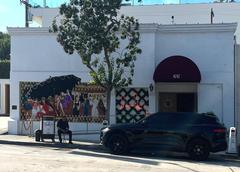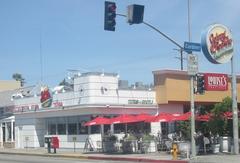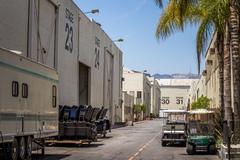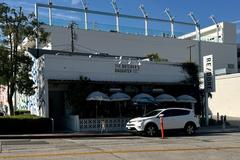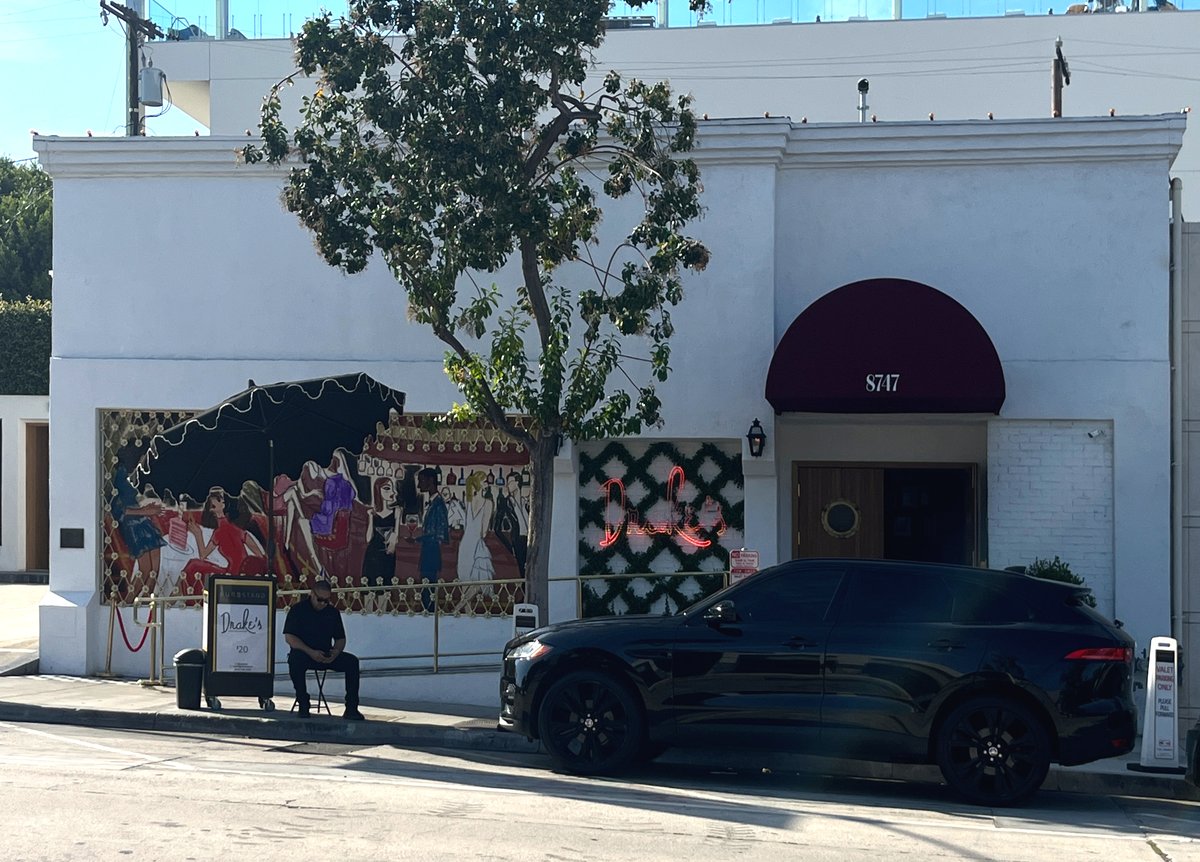
Melrose Avenue Los Angeles: Visiting Hours, Tickets, and Attractions Guide
Date: 14/06/2025
Introduction
Melrose Avenue is a quintessential Los Angeles destination, renowned for its dynamic blend of history, culture, art, shopping, and entertainment. Spanning over a century of urban evolution, Melrose Avenue encapsulates the spirit of LA—from its early 20th-century roots to its current status as a global fashion, art, and entertainment hub. Visitors can expect a multifaceted experience, with each district of the avenue offering unique landmarks, vibrant street art, boutique shopping, and a rich tapestry of culinary and cultural hotspots (Wikipedia; Melrose Avenue Shop).
This guide provides a comprehensive overview of Melrose Avenue, including its historical development, notable districts and attractions, practical visiting information, safety tips, transportation options, and advice for making the most of your visit.
Table of Contents
- Early Development and Urban Expansion
- Melrose as a Cultural & Retail Hub
- Architectural & Institutional Landmarks
- Districts & Notable Areas
- Street Art & Community Identity
- Visitor Information: Hours, Tickets & Accessibility
- Safety Considerations
- Transportation Options
- Practical Tips
- Nearby Attractions & Suggested Itineraries
- Special Events & Guided Tours
- Photographic Spots & Unique Features
- FAQ
- Conclusion
Early Development and Urban Expansion
Melrose Avenue’s story began in the early 1900s. Paved in 1909 and named after Melrose, Massachusetts, the avenue initially served as a modest residential and commercial corridor (Wikipedia). Its formal annexation into the City of Los Angeles occurred in 1922, expanding the city westward and laying the groundwork for Melrose’s transformation into a cultural and commercial artery.
A wave of development soon followed, with entrepreneurs like Henry C. Jensen constructing prominent buildings such as the Melrose Theatre in 1924. This era saw Melrose Avenue blossom into a diverse enclave, setting the stage for decades of growth and reinvention (Ukrainian Culture Center).
Melrose as a Cultural & Retail Hub
The 1980s: Punk, New Wave, and Artistic Flourishing
The 1980s marked a turning point for Melrose Avenue. The eastern stretches, particularly from Fairfax to Highland, became ground zero for LA’s punk and new wave scenes. Boutiques, record shops, and experimental fashion stores lined the street, attracting artists, musicians, and trendsetters. The area’s embrace of street art, graffiti, and vibrant storefronts cemented its reputation as a hotspot for underground culture and youth-driven trends (Melrose Avenue Shop).
Paramount Pictures and the Hollywood Legacy
A cornerstone of Melrose Avenue is Paramount Pictures, the last major studio operating in Hollywood. Founded in the 1910s, Paramount’s historic lot at 5555 Melrose Avenue has produced legendary films like “The Godfather” and “Sunset Boulevard.” Paramount’s ongoing public studio tours attract film buffs from around the world, reinforcing Melrose’s enduring link to the entertainment industry (Wikipedia; Melrose Avenue Shop).
Architectural & Institutional Landmarks
Jensen’s Melrose Theatre / Ukrainian Culture Center
Built in 1924, Jensen’s Melrose Theatre is a striking example of early 20th-century architecture. In 1961, the building was transformed into the Ukrainian Culture Center, which remains a vibrant hub for Ukrainian-American arts and community events (Ukrainian Culture Center).
Fairfax High School & Melrose Trading Post
Fairfax High School, located at the intersection of Fairfax and Melrose, anchors the local community. Every Sunday, its grounds host the Melrose Trading Post—a lively flea market featuring vintage goods, artisan crafts, and live music. The market is a beloved institution, drawing locals and tourists alike (Wikipedia).
Districts & Notable Areas
Melrose Heights
Melrose Heights, stretching from La Cienega to Fairfax, is famed for its upscale boutiques and luxury retail. Here, international fashion houses—including Alexander McQueen, Marc Jacobs, and Balenciaga—rub shoulders with design showrooms and fine art galleries (Wikipedia). The La Cienega Design Quarter further elevates the area’s reputation as a style and design mecca.
Melrose Place
A short, tree-lined street off La Cienega, Melrose Place is synonymous with boutique shopping and pop culture, thanks in part to the iconic 1990s TV show. The real Melrose Place offers charming specialty boutiques, beauty salons, and trendy cafes (Wikipedia).
Street Art & Community Identity
Melrose Avenue is famed for its ever-changing murals and vibrant street art. Since the 1980s, blank walls have served as canvases for local and international artists, turning the avenue into an open-air gallery (Melrose Avenue Shop). This tradition continues today, with new artwork frequently appearing, reflecting the community’s creative pulse and diverse identity.
Visitor Information: Hours, Tickets & Accessibility
- Street Access: Melrose Avenue is a public street, open 24/7.
- Business Hours: Most shops and restaurants operate from 10:00 AM to 8:00 PM. Nightlife venues may stay open later (Melrose Avenue Shop).
- Attractions: The Melrose Trading Post runs Sundays from 9:00 AM–4:00 PM (admission: ~$5). Paramount Pictures studio tours require advance tickets.
- Accessibility: The avenue is pedestrian-friendly and accessible by Metro bus, rideshare, bicycle, and scooter. Most locations are wheelchair accessible; some older buildings may have limitations.
Safety Considerations
Melrose Avenue is generally safe, especially in busy commercial areas and during daylight hours. Petty theft (like car break-ins) can occur, so keep valuables secure and use well-lit parking lots. Stick to main streets at night and avoid isolated areas (Reddit; Angel Times). For emergencies, dial 911.
Transportation Options
- Metro Bus: Several lines serve Melrose Avenue—Line 10 runs the length of the street, others connect via Highland, Fairfax, and La Cienega (Moovit; Go City).
- Rideshare: Uber and Lyft are widely available.
- Parking: Metered parking and paid lots are available, but fill quickly on weekends. Read signage carefully and avoid parking in restricted areas.
- Bikes & Scooters: Rentals (Bird, Lime, etc.) are popular for short trips, especially between districts.
- Driving: Traffic can be heavy; plan accordingly (The Evolista).
Practical Visitor Tips
- Visit on weekdays for lighter crowds; weekends (especially Sundays) are busiest due to the Trading Post (Angel Times).
- Dress comfortably and wear walking shoes—distances between districts can be long.
- Bring water and sun protection.
- Reservations are recommended for popular restaurants and special events.
- Many shops and cafes offer free Wi-Fi.
- Tipping is customary (15–20% at restaurants, for rideshare, etc.).
- Most staff speak English; Spanish and other languages are also common.
Nearby Attractions & Suggested Itineraries
- La Brea Tar Pits & Museum: Explore prehistoric fossils nearby.
- The Grove & Original Farmers Market: Popular for shopping and dining.
- Hollywood Walk of Fame: A short drive or bus ride away.
Suggested itinerary: Start with brunch near Melrose Place, shop and enjoy art murals in the central district, browse the Melrose Trading Post (Sundays), and finish with dinner at a trendy restaurant.
Special Events & Guided Tours
Melrose Avenue hosts art walks, trunk shows, and pop-up events year-round. Guided walking tours focusing on street art, history, or shopping can be booked online or through local tour companies (Melrose Avenue Shop).
Photographic Spots & Unique Features
Don’t miss the Paul Smith Pink Wall, “Made in LA” mural, and colorful market scenes at the Melrose Trading Post. Always be respectful of private property when photographing murals or storefronts.
Frequently Asked Questions (FAQ)
Q: What are the main visiting hours?
A: Shops and galleries usually open 10:00 AM–8:00 PM. The Melrose Trading Post operates Sundays, 9:00 AM–4:00 PM.
Q: Are tours available?
A: Yes—Paramount Pictures offers paid studio tours; walking tours of Melrose’s history and art are also available.
Q: Is Melrose Avenue family-friendly?
A: Absolutely. The Trading Post and Fairfax District are especially welcoming for families.
Q: Where can I park?
A: Metered street parking and paid lots are available; early arrival is advised on weekends.
Q: Are tickets required?
A: The street is free to explore; only specific events (like the Trading Post or studio tours) require admission.
Q: How do I get there by public transit?
A: Multiple Metro bus lines serve the avenue (Moovit).
Conclusion
Melrose Avenue is more than just a shopping street—it’s a living, evolving symbol of Los Angeles’ creative energy and cultural diversity. Whether you’re drawn by its rich history, street art, designer boutiques, or lively events, Melrose offers something for every taste and interest. Plan your visit with these tips in mind, and you’ll experience the very best of one of LA’s most iconic neighborhoods.
For the latest updates, insider guides, and self-guided audio tours, download the Audiala app and follow us on social media. Explore related articles for more ways to enjoy Los Angeles’ vibrant neighborhoods.
References and Further Reading
- Melrose Avenue, Wikipedia
- History of the Building, Ukrainian Culture Center
- Melrose Avenue Shop History
- Discovering Melrose, Angel Times
- Melrose Avenue Guide, Time Out Los Angeles
- Visitor Guide West Hollywood Neighborhoods, Westside Los Angeles
- Melrose Avenue, Melrose-Avenue.com
- Getting Around Los Angeles, Go City
- Visiting Los Angeles, The Evolista
- Melrose Avenue Transit, Moovit
- Me Gusta Los Angeles: Melrose Avenue
